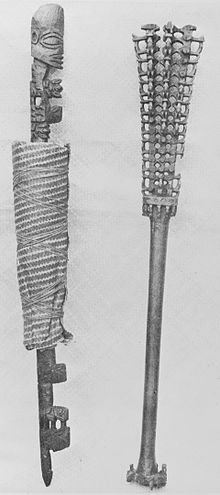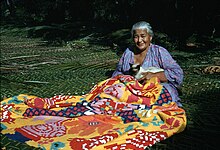Cook Islands art
Today, carving is no longer the major art form with the same spiritual and cultural emphasis given to it by the Maori in New Zealand. However, there are continual efforts to interest young people in their heritage and some good work is being turned out under the guidance of older carvers. Atiu, in particular, has a strong tradition of crafts both in carving and local fibre arts such as tapa. Mangaia is the source of many fine adzes carved in a distinctive, idiosyncratic style with the so-called double-k design. Mangaia also produces food pounders carved from the heavy calcite found in its extensive limestone caves.[1]
Carving
Carving was an important part of ancient Cook Islands culture, although much of this is lost. Ancient Cook Islanders carved the poles of their huts, their canoes and weapons (clubs and spears). The patterns used were the same as that used in
Staff god

Cult figures called staff god or atua rakau from Rarotonga, apparently combine images of gods with their human descendants. They range in length between 28 inches (71 cm) and 18 feet (5.5 m) and were carried and displayed horizontally. At one end there is a schematized blade-shaped head and arms of the progenitive god with a succession of little figures rising from his body, alternatively full-face and in profile with penis erect. The staff itself terminated in a phallus. But this elaborately carved sexual imagery had less importance for the Rarotongans than the feathers and pieces of shell representing the soul of the god and enclosed in yards of bark cloth wound around the center of the staff.[3]
Fisherman's god
A number of images called the fisherman's god are found in museums. These images are likely to be of the sea god Tangaroa.[4] Their function rests solely on the authority of John Williams, who figured one of them and referred to it thus:
"An idol, of which the figure on the opposite side is a correct representation, was placed on the fore part of every fishing canoe; and when the natives were going on a fishing expedition, prior to setting off, they invariably presented offerings to the god, and invoked him to grant them success." [5]
Weaving
The outer islands produce traditional weaving of fans, mats, basketware and hats. Particularly fine examples of rito hats are worn by women to church on Sundays. They are made from the uncurled fibre of the
Tattoo
Tattooing was forbidden in the Cook Islands after the arrival of missionaries, but has recently become popular again. Historically the Cook Islands tribes or clans each usually recognized a particular fish, bird, insect or plant that was sacred to that tribe and symbolized its unity. The ritual association requires members of the clan to treat the totem with respect. Its supernatural help could also be sought in times of distress. The symbol for the centipede with a poisonous bite is a common totem of chiefs and was normally tattooed on the chief's back.
Tīvaevae / Tivaivai

A major art form peculiar to the Cook Islands is tīvaevae / tivaivai. This is needlework, specifically the making of
They are often given as gifts of love and friendship. They supplanted the traditional giving of
Tivaevae / tivaivai has played an important role in the daily life of Cook Island women. Since it is largely a social activity, it is nearly always carried out communally, it has had a major impact on the lives of the many women who practise it. Despite its European origin, patterns and techniques have evolved into styles which now belong quite distinctly to the Cooks. The tivaevae / tivaivai reflect the women's surroundings and usually employ designs of flowers, leaves, birds, fish, insects and animals.[8]
Vereara Maeva-Taripo[9] and Tungane Broadbent are important tīvaevae / tivaivai artists.[10] Their work are in the overseas collections in Queensland Art Gallery,[11] Christchurch Art Gallery[12] and British Museum,[13] as well as locally in Cook Islands National Museum.[14]
Contemporary art
Contemporary Artists
Mahiriki Tangaroa produced a series of paintings depicting pre-Christianity gods of the Cook Islands titled Kaveinga – Angels of the Ocean, presented by Bergman Gallery in Venice, Italy as part of European Cultural Centre: Personal Structures in 2022 coinciding Venice Biennale.[16] Other notable Contemporary Cook Islands artists includes Ian George,[17] Kay George,[18] Sylvia Marsters, Nina Oberg Humphries,[19] and Joan Gragg.[20] Mike Tavioni is an important carver.[21] Bergman Gallery is a contemporary dealer gallery in Rarotonga that exhibits all the artists mentioned, and regularly participates in art fairs around the world, especially Aotearoa Art Fair (previously known as Auckland Art Fair)[22][23]
Gallery
-
Stone sculpture
-
Stone carving
-
Ornaments
-
Fans
-
Symbols of gods
-
Wooden images of gods
See also
- Literature of the Cook Islands
- Music of the Cook Islands
- History of the Cook Islands
References
- ^ Lords of the Dance - Culture of the Cook Islands: Visual arts
- ^ Arts & Craft Cook Islands: Build your love of art
- ^ A world history of art by Hugh Honour & John Fleming (2005)
- ^ Rarotonga & the Cook Islands by Errol Hunt & Nancy Keller, Cook Islands Myths and Legends: Gods
- ^ Arts and Crafts of the Cook Islands: Religion - nzetc.org
- ^ Lords of the Dance - Culture of the Cook Islands: Crafts
- ^ Oceania tattoos: Cook Islands tattoos - janeresture.com
- ^ Quilts of the Cook Islands: Tivaevae
- ^ "'Think wider, think beyond your horizon'". Cook Islands News. 2020-08-18. Retrieved 2023-10-12.
- ^ "Aotearoa Art Fair: A celebration of Pacific art". Cook Islands News. 2022-12-03. Retrieved 2023-10-12.
- ^ "BROADBENT, Tungane | QAGOMA Collection Online". collection.qagoma.qld.gov.au. Retrieved 2023-12-06.
- ^ "Kaute (Hibiscus)". christchurchartgallery.org.nz. Retrieved 2023-12-06.
- ^ "dress (Mu'umu'u) | British Museum". www.britishmuseum.org. Retrieved 2023-12-06.
- ^ "Tivaivai exhibit showcases masterful needlework". Cook Islands News. 2023-07-15. Retrieved 2023-12-06.
- ^ "BCA Gallery - Cook Islands Contemporary Art @ Rarotonga International Airport". Archived from the original on 2016-03-06. Retrieved 2011-05-16.
- ^ Structures, Personal. "Personal Structures". Personal Structures. Retrieved 2023-10-01.
- ^ "Creative New Zealand mourns the passing of Cook Islands artist Ian David George". creativenz.govt.nz. Retrieved 2023-12-06.
- ^ "A lifetime of colour". Cook Islands News. 2020-08-18. Retrieved 2023-12-13.
- ^ "Cook Islands Va'ine at Aotearoa Art Fair". Cook Islands News. 2022-11-12. Retrieved 2023-10-01.
- ^ "Religious celebration basis of Gragg's new exhibition". Cook Islands News. 2023-04-11. Retrieved 2023-10-12.
- ^ "Documentary on carver Mike Tavioni wins Paris Short Film Festival award". Cook Islands News. 2022-10-13. Retrieved 2023-10-01.
- ^ "Bergman Gallery to participate in Auckland Art Fair". Cook Islands News. 2020-08-18. Retrieved 2023-10-16.
- ^ "Cook Islands Va'ine at Aotearoa Art Fair". Cook Islands News. 2022-11-12. Retrieved 2023-10-16.
Bibliography
- The art of tivaevae: traditional Cook Islands quilting by Lynnsay Rongokea, John Daley (2001) ISBN 978-0-8248-2502-7
- Cook Islands art by Dale Idiens, University of California (1990) ISBN 978-0-7478-0061-3
- Arts and crafts of the Cook Islands: Volume 179 of Bernice P. Bishop Museum bulletin by Peter Henry Buck (1944)
External links
- The Success Story of Cook Islands Art
- The Cook Islands Art and Crafts Guide
- Cook Islands Crafts: Art from the heart
- Unu (Slab God) - Museum of New Zealand Te Papa Tongarewa
- No'oanga (wooden seat) - Museum of New Zealand Te Papa Tongarewa
- Toki (ceremonial adze) - Museum of New Zealand Te Papa Tongarewa






